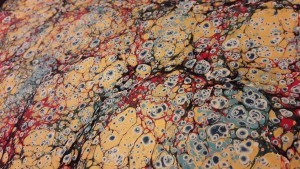
Ebru, which is a paper ornament art is a drawing conducted on water with high surface tension mixed with gum tragacanth or similar substances. During the drawing process, exclusive brushes are used to sprinkle paints on the formed specified substance and finally the drawing is placed on paper by scraping it on the outcome. On traditional ebru’s, which are used as side papers of bindings that frame the edges of lettering plaques, one can find cloud-like paint clusters. Ebrî, has a cloudlike meaning in Persian. In Şemsettin Sami’s Kamus-i Türkî dictionary, ebri is denoted in Chagatai as ebre (clothing), fur case, wavy like watering and venous (cloth, paper etc.), it means paper that is used to make covers for notebooks and fragments. Contemporarily, the art itself and papers that are produced by this method are named ebru. Vains that are seen on paper which are similar to marbling, Europeans name it as ‘marbled paper’, and Arabs call it “el-varaku’l-mücezza” (venous paper).
Researches in recent years show that in China, Japan and India techniques are utilized to encolour papers similar to that of traditional ebru art, and that its history dates back to the 8th century. The art came to existence in Turkistan in the 16th century. It is known that it was taught by masters from Bukhara and is brought to Anatolia by artists connected to religious cults. The Uzbekler Tekkesi (Uzbek lodge) in Üsküdar has paved the way for this art to be carried out and to pass it from generations to newer ones.
In the making process of ebru, clod paintings that do not dissolve in galenic water have been used as fat free paints. To prepare the water on which paint is going to be sprinkled, a kind of gum is needed. Instead of gum tragacanth, what can be also used are different materials such as badderlocks, flaxseed, salep, quince and starch. In order to put the paints above the liquid surface cattle gall should be used. The container in which ebru art is made is called a ‘tekne’. It is made of zinc, steel, galvanize or pendent (knotless pine). Paints are sprinkled on the surface of the water with brushes. In the making of brushes the tail hair of old horses are used and to wrap them around the brush rose branches are used. To engage in special ebru sorts, comb and bodkins are necessary as side materials. After papers with ebru are dried, they are polished through a seal method.
Among ebru sorts the following methods are known: battal, somaki battal, serpmeli battal, gel-git (come and go), şal, taraklı (combed), kumlu (sandy), dalgalı (wavy), bülbül yuvası, hatip, çiçekli (flowered) and akkâse. Contemporarily, ebru’s are made in traditional ways and paintings are drawn in steel containers with the ebru technique.




